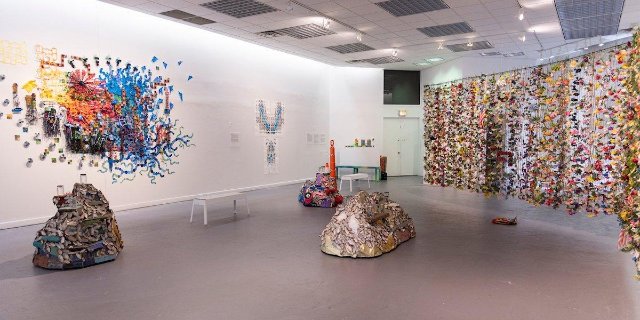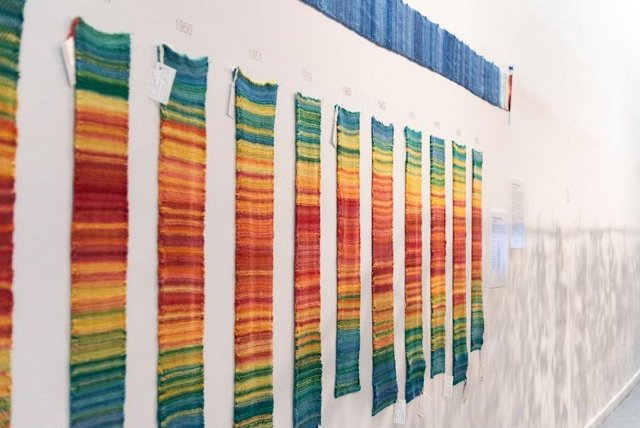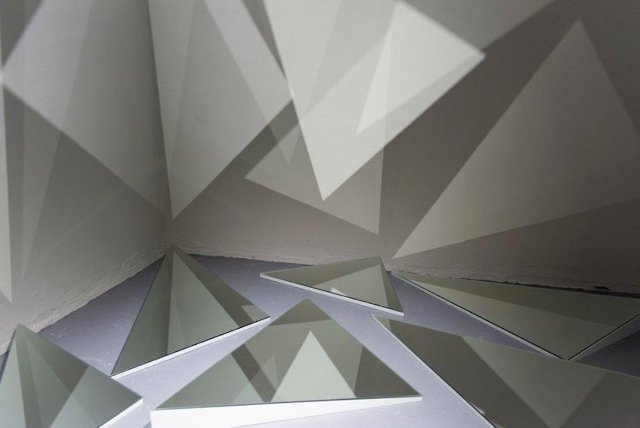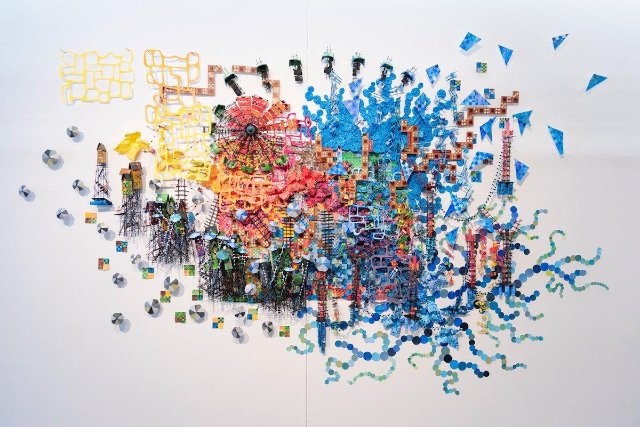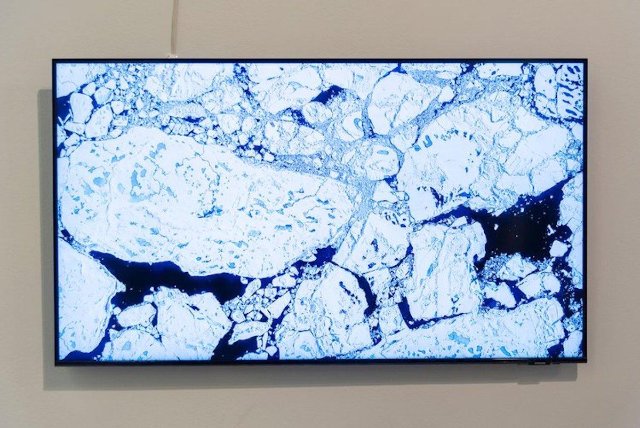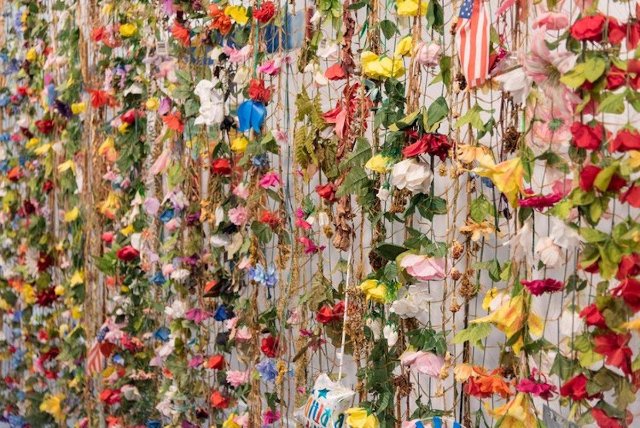At the Precipice
Design Museum of Chicago
By: Nancy Bishop - Aug 04, 2023
The beauty of art and the tragedy of the climate crisis live side by side in a stunning new exhibit at the Design Museum of Chicago. Some 30 pieces ranging in size from framed art to wall-length tell the story of why we are “At the Precipice” in this record-breaking hot and stormy summer of 2023.
The exhibit, which runs through October 30, was curated by Colossal, a digital arts platform that enhances the voices of artists working toward a more equitable and environmentally conscious future. Co-curators Christopher Jobson and Grace Ebert gathered the works by 10 artists and artist collectives, most of them Chicagoans, and designed the exhibit, which fills the Design Museum’s downtown storefront gallery.
When you enter the gallery, you are immediately faced by an expansive multicolor wall piece made up of about a thousand items, titled “Build Me a Platform, High in the Trees,” created by Nathalie Miebach. The artist explores art and science by translating meteorological data into sculptural works. This work draws on weather events that caused significant flooding in Louisiana since Hurricane Katrina.
Tanner Woodford, executive director of the museum, explained how the piece was installed. It arrived in four boxes with 28 pages of instructions. Created in 2017, it has appeared in exhibitions before, but may appear slightly different in each venue.
Another large piece is Selva Aparicio’s “Our Garden Remains,” a 2022 work that extends most of the length of the east wall of the museum and creates a beautiful shadow pattern on the wall behind it. It’s made up of real and plastic flowers and other decorations and ephemera collected from the trash bins of Chicago cemeteries. The items are threaded on cords that hang from a rope stretched across the wall, creating a curtain of grief. Aparicio, an interdisciplinary artist, explores ideas of memory, intimacy and the temporality of life.
Zaria Forman’s “Overview” (2014) is a video, shot by a drone, that flies across 12 miles of the Lincoln Sea in the Arctic Ocean north of Greenland. The beautiful blue imagery documents the tragic cumulative ice loss in Greenland. Forman documents climate change, usually with pastel drawings; she travels to remote regions of the world to collect images and inspiration for her work, which has been exhibited worldwide.
Redemptive Plastics’ exhibit, “Bench and Process Materials” (2023), demonstrates how the organization collects plastic laundry detergent jugs from laundromats in the Austin neighborhood and processes them into a lumber-like material that can be used for a variety of building projects. The exhibit shows jars of plastic trash in various stages leading up to the point of being melted, extruded and reshaped into building materials for benches, stools and chairs. A sturdy bench is positioned in front of the process materials. Suitable for sitting; we tested it out.
Redemptive Plastics is a collaboration between alt_Chicago, an artist-led, faith-based community nonprofit focused on revitalizing neighborhoods by using art as a tool; and Happy Returns Studio, a local studio working on robotics, recycling and recreation.
Focusing on precise climate change data, The Tempestry Project exhibit, “Paleo New Normal Tempestry” (2022), is made up of knitted pieces made by 30 local knitters (and counting). “Paleoclimatology” refers to climate data before instrumental records were available. The upper horizontal knitted strip of the exhibit represents Chicago temperatures from year 0 to 2021, with green and cool colors representing cool temps and red/yellow warm colors representing heat. You can see the heat patterns increase over the years. The second element in the exhibit is an extended row of small knitted rectangles, each reflecting the temperature pattern in Chicago on a single date in history. The Tempestry Project, co-founded by Asy Connelly and Emily McNeil, is still seeking more knitters to add to the day-by-day translation of temperature data into knitted art. If you are a knitter interested in contributing, you can contact the Design Museum.
Do I have a favorite work in this exhibit? I wouldn’t usually admit that, but both the concept of this work and its installation in “The Vault” make it the don’t-miss piece in the exhibit. “White Wanderer” was created by the Luftwerk Studio (Chicago-based artists Petra Bachmeier and Sean Gallero) as part of their ongoing investigation into the rapid disintegration of the Antarctic ice shelf. It represents Larsen-C, a 120-mile long crack along the Antarctic ice shelf that broke into a trillion-ton iceberg in 2017. When you stand in the vault, you can hear the sounds of Larsen-C. The geometric gray-and-white imagery is created by light forms reflected from triangular glass pieces on the floor projected onto the wall. The vault, with its original six-inch thick door, was actually a bank vault when the building was used for its original purpose as a bank.
Those are just a half dozen of the exhibits in At the Precipice, an exhibit that is both beautiful and sad. You will find yourself thinking that a particular piece is exquisitely lovely or fascinating in its design and then you are simultaneously confronted with its significance: The increased warming of our planet, disappearance of the Arctic and Antarctic ice masses, rising of the seas, increasing plastic trash, despoiled waterways.
Woodford said that they have had a regular flow of visitors since the exhibit opened on July 14, “Some people come in for 15 minutes and take selfies” while others spend an hour exploring all the exhibits. You can do either. The Design Museum of Chicago is located at 72 E. Randolph St., just east of Michigan Avenue. Admission is free. The museum is open daily 10am to 5pm.
If you are interested in scheduling a guided experience for a group, please contact the museum for details.

